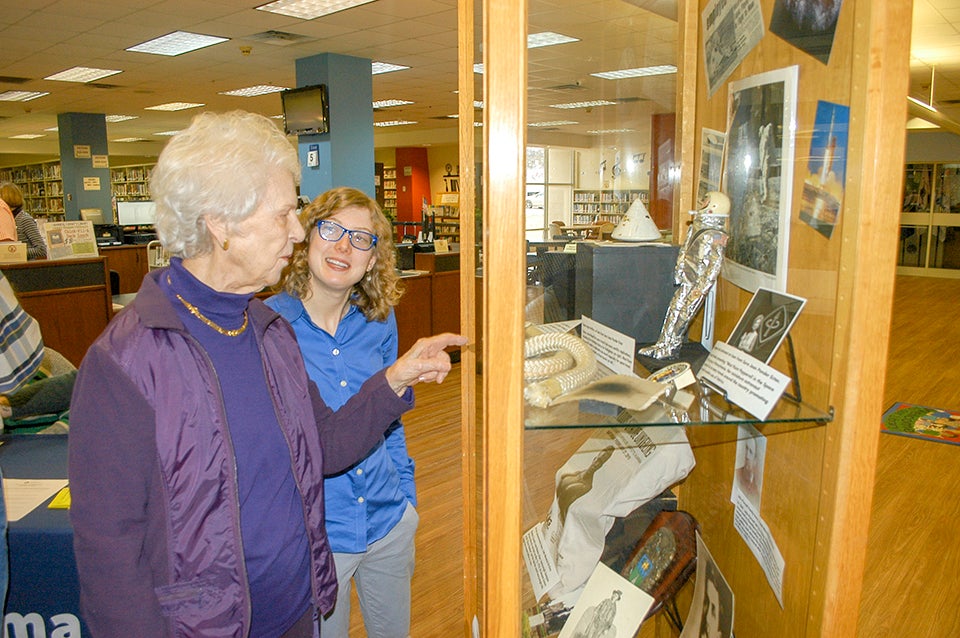Bradshaw-Chambers County Library talks about historic moon landing in 1969
Published 4:57 pm Thursday, February 7, 2019
VALLEY — In a Tuesday Lunch-N-Learn program at Bradshaw-Chambers County Library, Dr. Roger Launius talked about the successful U.S. effort to go to the Moon in the 1960s, why we stopped and whether or not future attempts will be made to go back.
During a 35-year career as a U.S. government historian, Dr. Launius has been involved in many issues relating to public history and the history of aerospace technology. Between 2002 and 2017, he worked in several positions in the Smithsonian Institution’s National Air and Space Museum in Washington D.C., most recently as associate director for collections and curatorial affairs. He is now the principal for Launius Historical Services.
In addressing the topic “the Many Faces of Lunar Exploration,” Launius said that in the early 1950s the American public was fascinated with the possibility of exploring space and going to the Moon. Science fiction movies of the period had such themes and publications, such as the then-popular Collier’s magazine, that were richly illustrated with color reproductions of artists like Chesley Bonestell.
For most people, it was a pipe dream. But in October 1957, Americans faced the sobering reality that the country was in a space race. The post-war nemesis Soviet Union had successfully launched the world’s first man-made satellite, Sputnik I.
“In 1958, Congress created NASA (National Aeronautics and Space Administration) and the space race was here,” Launius said.
There was great demand for people skilled in what’s now called STEM education – science, technology, engineering and math.
In just three years a new president, John F. Kennedy, announced a goal of sending manned missions to the Moon and to have them safely returned by the end of the 1960s.
Launius said that popular culture immediately took to the idea. In his PowerPoint presentation, he showed a cartoon by the famed Herblock, showing JFK in a space suit pulled into a gas station and telling Congress, symbolized as the gas station attendant, to “Fill ‘er up. I’m in a race!”
Largely due to Cold War competition against Russia and the quest for American exceptionalism, the country was fully behind the race to the Moon. The young men chosen to be astronauts were treated like rock stars.
Getting men to the moon was a three-step process. “The first was the Mercury project,” Launius explained. “It had three manned missions between 1961 and 1963. Then came Gemini, which was stunningly spectacular. It had ten successful missions between 1965 and 1966.”
The third and final step was Apollo, which got us to the Moon. It began with a terrible tragedy. The three astronauts chosen for Apollo I – Gus Grissom, Ed White and Roger Chaffee – were killed in a flash fire during a training exercise. That set the program back for some time, but it was obvious the program was heading toward success when Apollo 8 circled the Moon during the Christmas season of 1968. The mission is remembered for an iconic photo taken while the spacecraft was rounding the Moon and heading back to Earth. In the foreground is the lunar surface and the earth appears as a big blue ball against the black backdrop of space.
“That photo made us realize that everything we know is on that blue ball,” Launius said.
“Astronauts were national heroes,” Launius said. “They were in the public eye and featured on such programs as Bob Hope Christmas specials. Some had good public relations skills and loved it, while others didn’t. Neil Armstrong, the first man to walk on the moon, saw himself as an engineer who worked with slide rules all the time. Buzz Aldrin (the second man to walk on the Moon) loved public adulation and still does. He loves the long lines that come to see him.”
Launius said that he will never forget that first Moon landing on July 20, 1969. “I was 15 years old at the time and was on a double date with one of my friends from high school,” he said. “The girl I was with sat with me on the hood of the car and looked up at the Moon, knowing that three Americans were there (Armstrong, Aldrin and command module captain Michael Collins) We listened to what was happening on the car radio.”
Launius said that Apollo had six more missions before the program was discontinued after the Apollo 17 mission in Dec. 1972. A popular movie was made about Apollo 13, in which three astronauts somehow managed to get back home after having an accident en route to the Moon.
Launius cited Apollo 17 as the mission that best summed up why we haven’t been back. “It was the first mission to have a geologist, Harrison Schmidt,” he said. “When you get down to it, geologists are the only people who would want what’s there. There’s a whole lot of rocks.”
Launius made the point that safely getting men to the Moon and getting them safely back home is what motivated the endeavor.
“Everything had been driven by getting something,” he said. “There has to be something of value that’s there to sustain that interest.”
Why would we go back?
“There has to be something that can be monetized,” Launius continued. “There’s a fine line between pride in success and American exceptionalism.”
“Was Apollo worth the cost?” Launius asked. “Polls of that time period showed strong support on the part of Americans while we were doing it. That support dropped after the launch pad fire where three astronauts got killed, but peaked again after Apollo 8 and remained strong after the successful landings.”
The pride of doing this was high, but it changed when respondents were asked about the cost. ‘“We like it,’ the sentiment went,” said Launius, “but we just don’t want to pay for it. It’s been that way ever since.”
When Apollo was discontinued, the next step was the Space Shuttle, a successful program but best known for two tragedies.
“We could go back, and we could go to Mars,” Launius said, “but you have to have a reason to do it.”
Launius said there are 86 countries capable of putting satellites in orbit. Some countries make their own rockets and some contract with other countries to do the launching.
China made news recently by having the first soft landing on the far side of the Moon.
“The U.S. and Russia are the only two countries with mature space programs,” he said.





